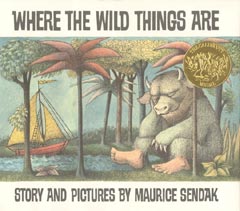Maurice Sendak

 |
and rolled their terrible eyes and showed their terrible claws
but Max stepped into his private boat and waved goodbye
and sailed back over a year and in and out of weeks and through a day
and into the night of his very own room, where he found his supper waiting for him
and it was still hot.”—Where the Wild Things Are
“I've devoted my life to those other freaky kids who lick, sniff, and carry on over their books before they even read them.”—Maurice Sendak, Childhood Books I Remember
“Perhaps no one has done as much to show the power of the written word on children, not to mention on their parents, as Maurice Sendak.”—President Clinton, January 9, 1997.
Maurice Sendak wrote more than 80 books. He won almost every important prize in children's literature, from the Caldecott Medal, to the Hans Christian Andersen Award, to the American Library Association's Laura Ingalls Wilder Award. He called the National Medal of Arts “my first grown-up award.” He wrote one of the best-selling children's books of all time, which also spawned not only a video, but a movie, an opera, a ballet, countless stuffed toys, and generations of four-year-olds who call themselves Max after the King of All Wild Things. In the last years of his life, Sendak branched out to designing sets and costumes, working on videos and a children's television series, and founding a children's theater company, The Night Kitchen.
Sendak's work was deeply grounded in his respect for children. Sendak said, “The point of my books has always been to ask how children cope with a monumental problem that happened instantly and changed their lives forever, but they have to go on living. And they cannot discuss this with anyone. No one will take the time. Parents are embarrassed so they'll shush them up.A0801320.html”
Much of Sendak's work was dark—evoking the Brothers Grimm more than Dr. Seuss. Ida's sister was stolen by goblins, Pierre got eaten by the lion, and Max was—well, a Wild Thing. Sendak called We Are All in the Dumps With Jack and Guy “an in-your-face book about homelessness”; it begins when “the rats stole the kitten and the poor little kid.” In his illustrations for Isaac Bashevis Singer's Zlateh the Goat and Other Stories, Sendak included portraits of relatives who died in the Holocaust. The loose trilogy of Where the Wild Things Are, The Night Kitchen, and Outside Over There explored children's very primal fears. Outside Over There, on the surface a wonderful tale of a changeling rescued by music, had its genesis in Sendak's childhood traumas over the kidnapping and murder of the Lindbergh baby.
Sendak's ability to present a child's view of the world sometimes made parents uncomfortable. In a copy of Night Kitchen in a local public library, someone inked in pants on the naked pictures of the little boy Mickey. Sendak said it's not the first time. Stephanie Tolan, who writes novels for older children (most recently Welcome to the Ark) said: “There are many people (few of them children) in the world of children's literature (and rather more outside it) who are offended by some of Sendak's work for a variety of reasons. But I believe those to be the people who don't remember childhood, who have repressed it and like to look back on it as a lovely time of play and innocence and joy. Sendak has a real ability to enter the landscape of childhood—REAL childhood—and render its lights and its shadows, too. There is nothing cutesy about Sendak's work, though the monsters in Where the Wild Things Are are rather splendid companions rather than the creatures of nightmare.”
In his life as in his books, Sendak was a passionate advocate of children: “These are difficult times for children. Children have to be brave to survive what the world does to them. And this world is scrungier and rougher and dangerouser than it ever was before.”
See The Best-selling Children's Books of All Time.
